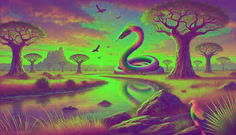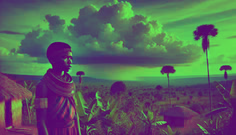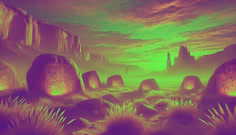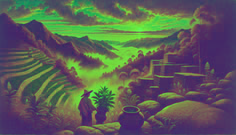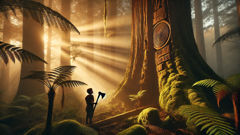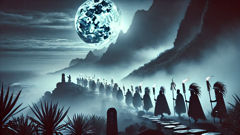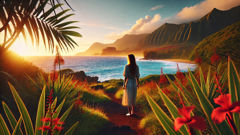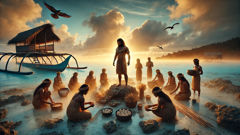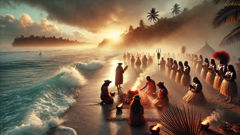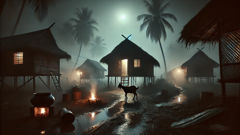Introduction
Before there were shores to hear the breath of surf, before coconut palms bowed over sand, there was Tagaloa—singular, vast, and complete in himself. He rested within a silence deeper than any lagoon, a silence not empty but swollen with possibility. From that silence Tagaloa stirred, feeling the slow turning of being into wanting: wanting to name, wanting to give shape, wanting to see his own thought become a place to walk. He extended a hand and from his gesture rose the first waves, curling like written ink across a blank ocean. He sang, and sound collected into islands—small at first, like the seeds of a dream, then larger as the music deepened. Stones rose where his foot pressed, ridges formed where his fingers sketched, and clay pooled where patience had promised. The sky hung close, a blue cloth Tagaloa lifted and set upon high poles, and between sea and sky he breathed life. From the warmth of his being grew plants that tasted of salt and sun; from the hush inside his chest grew animals that remembered the sea's first rhythm; from his own laughter came the first human voice, shaping language like shells into stories. This is the Samoan creation myth of Tagaloa, a tale told by elders beneath pandanus roofs and on winds that carry taro fragrance across reef flats. It speaks of kinship between people and place, of gods who are not distant rulers but intimate makers whose presence continues in the way islands harvest rain, in the way tides keep the heartbeat of villages, and in rituals where a whisper can still call the past into the present. Listen to the sound of Tagaloa's making: it is the creak of canoe outriggers, the hush of night when stars ripple above, the soft footfall of children running toward the sea—echoes of a single origin that shaped Samoa and its people.
Birth of Islands and Sea
Tagaloa's solitude was not barrenness but a dense seedbed. He walked the vastness and each step became a rock; each breath fogged into tide. In the earliest hour, when the quiet was a presence itself, Tagaloa opened his hands and shaped the first isles. They rose slow as thought—ringed with black basalt, speckled with bleached coral. He did not merely pile earth; he carved intention into land. He pressed his palms into the ocean floor and drew up ridges like the bones of a new world; he left hollows that became lagoons, clear as polished shell, where the first fishes would learn to weave between reef and reef. The making was tactile: Tagaloa's fingers pressed valleys, his thumbs smoothed plains, and where his nails scraped, volcanic glass glinted under newborn sun. As islands gathered, reefs followed. Tagaloa plaited them with coral, commanding small lives into being with a whisper that felt like a tide. The coral began to grow in branches and rings, building the first reefs that would shelter lagoons and birth fisheries. In this making, the sea took a form both generous and dangerous—depths to be respected, shallows to be used, currents that held memory.
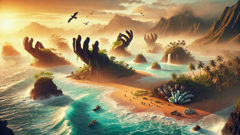
Tagaloa named each gesture. Name was not a label alone but a law. Where he called with a low, rolling syllable, a mountain kept that name in its weather for generations; where he sang, streams learned direction and rain learned to fall in certain places. The naming bound place to story. Villages would later take those names as lineage, and families would claim descent from a certain reef's first fish or a particular grove of breadfruit. In Tagaloa's making, functional and sacred were the same: the tree that bore fruit also bore oath; the rock that jutted from the surf also bore witness. The architecture of place came from imagination and need in one breath—terraces for taro where slopes had been tamed into steps, deep pools that held sweet water where volcanic seams met rain. Polynesian voyagers who would later find these islands would read the sea's currents and the stars' distances like a map already written by Tagaloa's hands.
The process of creation kept rhythm like drumming on a fale's post. Tagaloa moved in cycles: he created, he paused, he looked, and then he tested. He sent wind across newly formed plains to see which way the palms would lean; he let rains run down mountains to see if rivers would cleave the land in ways that made sense for life. Some islands he made plain and broad for gardens; others he left jagged and high, guardians of cloud forests. He fashioned shallow shelves and deep drop-offs, knowing that diversity would seed resilience. Where Tagaloa's patience ran short, jagged coasts rose and stirred storms; where he lingered, gentle beaches waited with fine sand. Fish learned to read those shorelines. Birds marked the mountains as roosts, and crabs claimed every shadowed rock. Slowly, the archipelago learned to be itself: a chorus of different voices bound by one ocean. The sea, too, had character. Tagaloa gave it moods—placid as glass, fierce as a drumbeat, reflective like a mirror when the sky leaned low. People centuries later would listen to the sea and find the same moods traced in ceremonial songs and fishing chants.
The first humans, the smallest sparks of Tagaloa's vast body, came when he split a breath into two and warmed clay by his hearth. He shaped them with care and taught them the first tasks: to plant, to fish, to weave, to tell. He set them near the shore and taught them the language of canoe building, showing how trees had a grain that favored an outrigger or a single hull. From the breath of Tagaloa, they learned to paddle by the stars. Their first songs were borrowed from the ocean’s swell; their earliest prayers asked for steady wind and soft rain. Tagaloa did not simply give life; he taught reciprocity. Each gift carried a responsibility: the plants that flourished asked for tending; the sea that fed asked for laws of harvest. This was the seed of fa'a Samoa—the Samoan way—where people learned to live in a relationship of respect to land, sea, and sky. Every rite of planting, every ritual at sea, traces back to that original contract: the maker gives life, and the made returns care. Over time those human communities shaped the islands in turn—terracing for taro, shaping fish traps from rock, and building fale whose structure echoed the ribs of Tagaloa's first boats. Through this mutual shaping, geography and culture braided together, a living testament to Tagaloa's first generosity.
Sky, Life, and Sacred Practices
Tagaloa's making did not stop at land and sea. The sky required ceremony: it had to be lifted, hung, and honored. He reached upward and gathered blue—an infinite lapis that he smoothed and stretched. He fixed luminous points into that blue, planting stars like brightly polished beads. Some stars were names; some were anchors for navigation; some were the eyes of ancestors who promised to watch and guide. When Tagaloa bound sky to horizon, he taught the people to read it. He showed them how certain stars marked the season to plant, how cloud patterns promised rain, how the moon's face timed the rhythms of fishing. The celestial map was also a moral map: those who read it correctly learned timing and patience; those who ignored it found themselves lost at sea or untimely with harvest. Tagaloa's imprint on sky and season became the calendar of culture.

Life emerged in multiplicity. From Tagaloa's sweat grew forests where birds learned to embody color; from his laughter hopped the first flying insects that would populate the under-canopy's hush; from his tears carved the freshwater springs that would raise kalo mounds and feed villages. Plants and animals were gifts and teachers. Breadfruit offered sustenance and shade; the coconut taught resourcefulness, its husk and milk and oil serving many needs. The giant pandanus taught how to weave and construct; the banana lent sweetness in times of scarcity. Tagaloa endowed each living thing with a role and an instruction—for example, the pig became both a food and a symbol of honor, to be given in ceremony with gratitude and precise ritual. These roles would structure the social world: the exchange of eating, gifting, and naming made obligations visible. Ceremonies arose to honor these links: first-fruit offerings to land, nets away rituals to appease the ocean, and kava ceremonies that echoed Tagaloa’s communal sharing. Such acts were not mere performance; they renewed the contract that underpinned life. They reminded people that Tagaloa's gift required stewardship.
As communities multiplied across islands, they forged practices that bridged the human and the divine. Family genealogies—fa'alupega—were recited to recall which reef and ridge a lineage belonged to, binding identity to place. Elders would tell stories of Tagaloa's gestures to instruct younger generations about how to behave toward land and kine. Canoe launching was accompanied by incantation, calling Tagaloa not as a distant king but as a nearby maker whose favor mattered. The building of a fale opened with offerings honoring the timber that once grew in Tagaloa's gardens. Even the naming of children often referenced the natural world Tagaloa had given: names that mean 'wave', 'breadfruit', 'strong wind' persisted, as if each newborn carried a tiny map back to the primeval making. This deep lore sustained practical knowledge: how to read currents, how to manage tree crops, how to sow so soil remained fertile. It was knowledge grounded in myth, practical and poetic at once.
Yet Tagaloa's world is not simple paradise. Creation contains balance—edges where danger remains. The gods taught that hubs of abundance could also become sites of transgression. Overfishing, disrespect toward tapu groves, and the misuse of kava in later stories are framed as forgetting the reciprocal terms Tagaloa set. Myths recorded these lapses as cautionary episodes: storms that strip crops, tides that swallow coastal gardens, and the occasional curse that rebalances a community that has grown careless. These narratives maintained social discipline through cosmology. When people in Samoa speak of conservation today, they often invoke these old laws—sometimes explicitly, sometimes in the cadence of chant or the choice to leave a fishing ground fallow. The voice of Tagaloa is thus present in sustainability: the island is to be used, but with measures that ensure continuity. In many ways, this wisdom of measured harvest and respect for place predates modern conservation discourse but arrives at similar conclusions—a recognition that human flourishing depends on reciprocal measure.
Long voyages across Pacific swell would later weave Tagaloa into a wider Polynesian tapestry. Sailors carried tales of the maker who lifted sky and stitched islands across an ocean like a scattered necklace. These stories both connected and distinguished communities: the Tagaloa of Samoa shared echoes with Tongan or Samoan cognates, yet local detail always mattered—specific reefs, groves, and ancestral names made each island’s telling unique. When chiefs and orators recited the Tagaloa myth at ceremonial gatherings, they did more than entertain; they anchored claim to land and to history. They reminded listeners that their place in the world had been conferred by a sacred action and that their identity as Samoan carried both privilege and responsibility. The mythology of Tagaloa therefore remains a living text, read aloud in meeting houses, whispered to children at dusk, and kept in the cadence of ceremonial speech. It is at once a creation myth and a charter for living in a fragile, generous, and beautiful place.
Conclusion
To walk Samoa is to walk a living echo of Tagaloa's hands. Paths that thread taro terraces, reef flats still patterned by ancient reef-building, and the names of villages hold fragments of that first making. The Samoan creation myth of Tagaloa is neither relic nor mere romance; it functions like law and memory, instructing how people tend to place and to one another. Modern Samoans continue to sing of Tagaloa in ceremonial speech, in lullabies that hush children at night, and in proverbs that remind a person to balance want with care. When communities face storm or scarcity, elders sometimes reach for the old stories not simply to explain but to heal—to recall a long-standing contract of reciprocity. Conservationists and cultural stewards today often find common ground with these ancient principles, showing that traditional knowledge grounded in myths can help shape resilient futures. Tagaloa's myth anchors identity, ties people to the sky, the sea, and the soil, and models a kind of creative care: making that still asks for tending. The islands, after all, are not finished; they require voices—stories, songs, and ritual—to remain whole. In every reef, in every breadfruit grove, in the cadence of a canoe's paddle there is a line back to that solitary maker. The legend of Tagaloa remains an invitation to remember, to act with gratitude, and to live as if every place were both a gift and a mandate.



